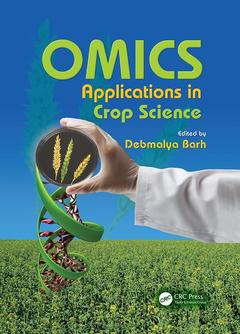Description
OMICS Applications in Crop Science
Coordinator: Barh Debmalya
Language: English
Subjects for OMICS Applications in Crop Science:
Keywords
SSR Marker; QTL; Genetic Engineering in Potato Improvement; DNA Methylation; Omics Approaches in Tropical Fruit Crops; QTL Region; Molecular Farming in the Decades of Omics; DNA Marker; Genetic Engineering in Ornamental Plants; Cad; Bioenergy Crops Enter the Omics Era; QTL Analysis; Genetic Linkage Map; RAPD Marker; HMG CoA Synthase; Brassica Genomes; Cotton Ber; Brassica Species; Bisindole Alkaloids; QTL Mapping; RIL Population; EST Database; Molecular Farming; Sugarcane Cultivars; Ber Elongation; Ge Ne; Tall Fescue; SNP Marker; Brassica Crops; Ber Quality
Publication date: 04-2017
· 17.8x25.4 cm · Paperback
Publication date: 12-2013
· 17.8x25.4 cm · Hardback
Description
/li>Contents
/li>Readership
/li>Biography
/li>
Merging topical data from recently published review and research articles, as well as the knowledge and insight of industry experts, Omics Applications in Crop Science delves into plant science, and various technologies that use omics in agriculture. This book concentrates on crop breeding and environmental applications, and examines the applications of various omics technologies including genomics, transcriptomics, proteomics, metabolomics to important agronomic, horticultural, medicinal, plantation, fiber, forage, and bioenergy crops.
It covers the application of omics technologies in several important crops, including cereal, and pulse. It explores the brassica species, drought tolerance in rice, and genetic engineering of the potato. The book discusses temperate fruits; and omics of medicinal plants, the metabolomics of Catharanthus roseus and how the medicinally important alkaloids of the plant are produced, as well as the omics of another important medicinal plant, Withania somnifera. It examines floriculture, the omics advances in tea, and omics strategies in improving the fiber qualities of cotton. It provides omics-related information on forest trees and forage crops, and offers a detailed account on how omics technologies are applicable in molecular farming, along with associated issues such as commercial aspects of molecular farming, clinical trials of plant-produced pharmaceuticals, regulatory issues and intellectual property rights.
Written as a resource for plant biologists, plant breeders, agriculture scientists, researchers and college students studying various fields in agriculture, and the agri industries, OMICS Applications in Crop Science compiles the latest research in this essential field of modern crop and plant science utilizing various omics technologies and their applications in a number of important crops/plants from agronomy, pomology, olericulture, floriculture, medicinal plants, plantation and energy crops, agro-forestry, and more.
Omics-Based Approaches for Rice Improvement. Practical Omics Approaches for Drought Tolerance in Rice. Omics Approaches in Maize Improvement. Omics Approaches in Pulses. Genetic Engineering in Potato Improvement. Omics Applications in Brassica Species. Integrating Omics Approaches in Sugarcane Improvement. Recent Advances in Temperate Fruit Crops: An Omics Perspective. Omics Approaches in Tropical Fruit Crops. Catharanthus roseus: The Metabolome That Represents a Unique Reservoir of Medicinally Important Alkaloids under Precise Genomic Regulation. Omics of Secondary Metabolic Pathways in Withania somnifera Dunal (ashwagandha). Genetic Engineering in Ornamental Plants. Omics Advances in Tea (Camellia sinensis). Omics Approaches to Improving Fiber Qualities in Cotton. Forestry and Engineered Forest Trees. Application of Omics Technologies in Forage Crop Improvement. Bioenergy Crops Enter the Omics Era. Molecular Farming in the Decades of Omics. Natural Pesticidome Replacing Conventional Pesticides. Intellectual Property Rights in Plant Biotechnology: Relevance, Present Status, and Future Prospects. Index.
Debmalya Barh (MSc, MTech, MPhil, PhD, PGDM) is the founder and president of the Institute of Integrative Omics and Applied Biotechnology (IIOAB), India. He started his early career as a horticulturist and later transformed himself as an active researcher in multidisciplinary cutting-edge "omics" fields including plantrelated omics. He has worked with nearly 400 researchers from 30–35 countries and has more than 100 high impact publications to his credit. He is a well-known editor for several research reference books in the foremost domains of "omics". OMICS: Applications in Biomedical, Agricultural, and Environmental Sciences is one of these books related to plant omics, published by Taylor & Francis in 2013.
These books may interest you

Plant OMICS and Crop Breeding 148.11 €



